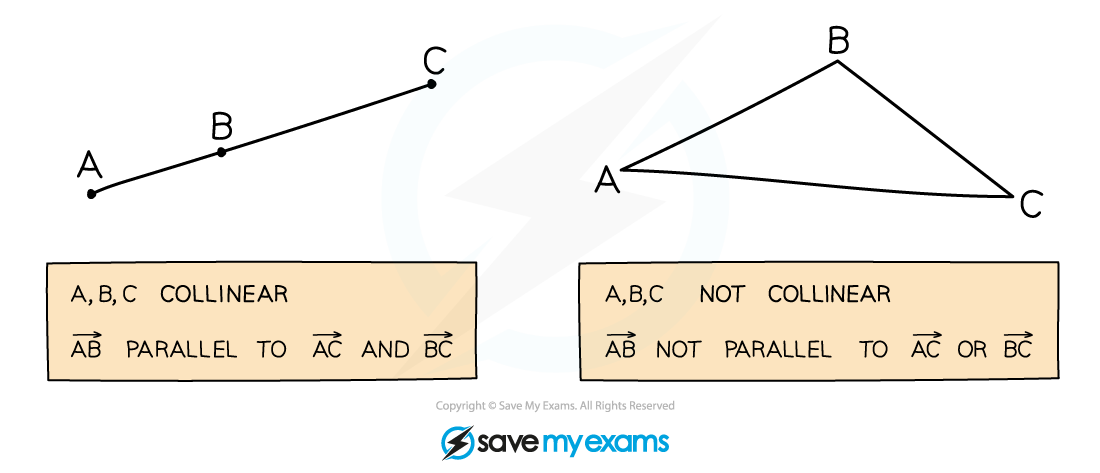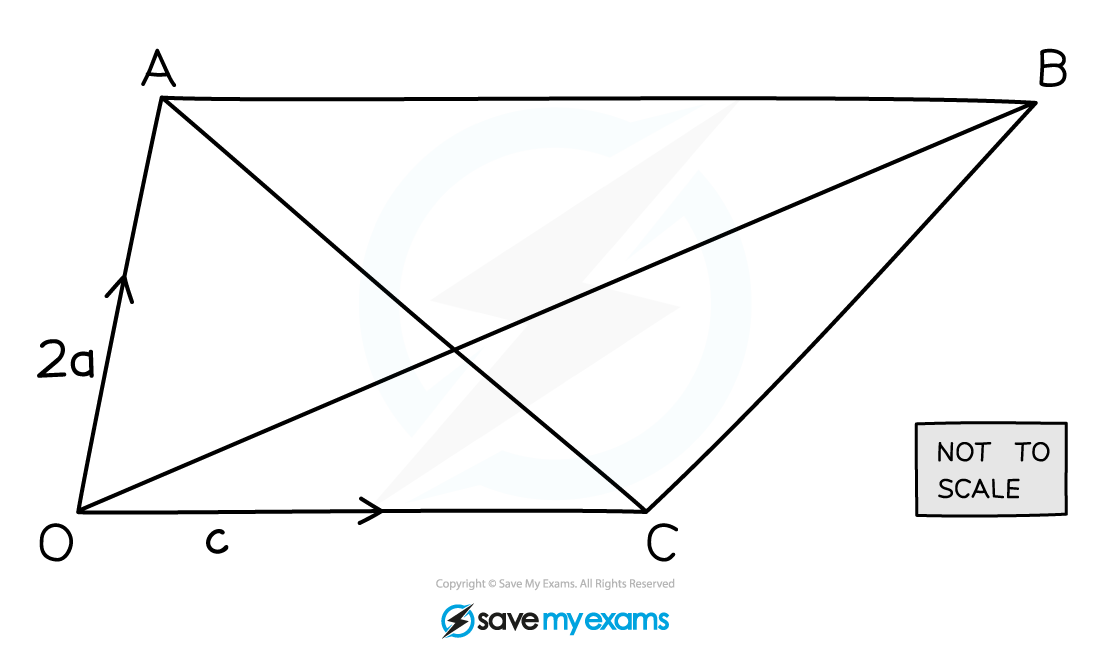Geometric Proof with Vectors (Edexcel IGCSE Further Pure Maths): Revision Note
Exam code: 4PM1
Vector Paths
How do I use vector paths?

A vector path is a path of vectors taking you from a start point to an end point
On the diagram shown
F to B has the path F to A to B
There are other possible paths too
F to G to B
You can write vector paths in terms of vectors given (a, b, ...)
The rule
helps
Vectors given can be used to build bigger paths
Different correct paths simplify to the same final answer
How do I use ratios in vector paths?

Convert ratios into fractions
In the example shown, if
then
The ratio 3:5 has 3 + 5 = 8 parts
Always check which ratio you are being asked for
Examiner Tips and Tricks
Mark schemes will accept different correct paths, as long as the final answer is fully simplified.
Check for symmetries in the diagram to see if the vectors given can be used anywhere else.
Worked Example
The following diagram shows a grid formed of identical parallelograms.
Vectors and
are given by
and
respectively.

Find the following vectors in terms of and
, fully simplifying your answer.
(a)
There are many ways to get from E to K
One option is E to O (b twice) then O to K ( -a four times).
-4a + 2b also accepted
(b) , where
is the point on the line
such that
.
Start by imagining the vector
It is easy to write this vector in terms of a and b
To find , use the given ratio to write it as a fraction of
There are 1 + 3 = 4 parts
Substitute in the known expression for
Expand and simplify to get the final answer
Parallel Vectors
How do I know if two vectors are parallel?
Two vectors are parallel if one is a scalar multiple of the other
This means if b is parallel to a, then b = ka
where k is a constant number (scalar)
For example,
and
so
b is a scalar multiple of a, so b is parallel to a
If the scalar multiple is negative, then the vectors are parallel and in opposite directions
c is parallel to a and in the opposite direction
How do I use factorisation to show two vectors are parallel?
If two vectors factorise with a common bracket, then they are parallel
They can be written as scalar multiples
For example
9a + 6b factorises to 3(3a + 2b)
12a + 8b factorises to 4(3a + 2b)
This means
so they are scalar multiples of each other
and therefore parallel

Examiner Tips and Tricks
If a question asks you to show that two vectors are parallel
Don't stop after showing two vectors are scalar multiples of each other
You must conclude with "therefore a and b are parallel" to get all the marks!
Worked Example
Show that the vectors and
are parallel.
It helps to write b in the same order as a
Factorise both vectors to form a common bracket
Write b in terms of a
It can help to make the brackets the subject of the first equation, i.e.
Then substitute that into the equation for b
Write a conclusion showing the scalar multiple
State that this shows they are parallel
therefore b is parallel to a
You could also use
Collinearity
What does collinear mean?
The points A , B and C are collinear if they all lie along the same straight line
In the image on the left in the diagram below, the following vectors are all parallel:

How do I use vectors to show that three points are collinear?
To show the points A , B and C are collinear
prove that two line segments are parallel
and show that there is at least one point that lies on both segments
This makes them parallel and connected (not side-by-side)
For example, if you show that
then
the line segments AB and BC are parallel
and they have a common point, B
So A , B and C must be collinear
Similarly,
means AC and AB are parallel
and they have a common point, A
so A , B and C must be collinear
How can collinearity be used when extend lines?
Extending the line segment OA means continuing the straight line beyond A
If the extended line passes through the point X
then O , A and X are collinear
To test whether another point, Y , is on OA extended
test whether O , A and Y are collinear
Examiner Tips and Tricks
Even though it's 'obvious' that
and
have a common point at A, you should still write this fact in your answer to complete a collinearity proof.
Worked Example
The diagram shows a quadrilateral, , where
It is also know that

(a) Juan believe that the point , which is halfway along
, lies on the line
.
Show that ,
and
are not collinear.
O , X and B are collinear if two line segments are parallel and share a common point
Consider the vectors and
They have a common point, O
Check if they are parallel by first finding
Expand and simplify
Now compare it to (given in the question)
Try factorisation to write in terms of
The inside the brackets matches the
in
But the inside the brackets does not match the
in
Therefore you cannot write and
as scalar multiples of each other
is not a scalar multiple of
Therefore OX and OB are not parallel
O , X and B cannot be collinear
(b) Maria believes that the point , which is three quarters along
from
, lies on the line
.
Show that ,
and
are collinear.
Similarly to part (a), find and see if it is parallel to
Use factorisation to write in terms of
So OB is parallel to OY
They also have a common point, O
Therefore OY and OB are parallel
They also have a common point, O
Therefore O, Y and B are collinear
Equating Coefficients of Vectors
How do I equate coefficients of vectors?
In the vector
the coefficient of a is
the coefficient of b is
Two vectors can only be equal if all their coefficients are equal
So if the vectors
and
are both equal
then
(by equating coefficients of a)
and
(by equating coefficients of b)
How do I use equating coefficients to find points of intersection?
Some diagrams have vectors that meet at a point
These are called concurrent vectors
To find this point, create two different vector paths that approach the point from different directions
Then set them equal and equate coefficients
For example, if the lines AB and CD intersect at the point P , find
One path is along the line AB
A , P and B are collinear
so
(they are parallel)
Another path is along the line CD
For example,
C , P and D are also collinear so
is a different scalar to
Set both paths equal and equate coefficients
This forms simultaneous equations in
and
Solve these and substitute their values back in to find
Examiner Tips and Tricks
The method of equating two different paths is really useful for other hard situations.
For example, extending lines out of a diagram, or continuing lines within a diagram.
Worked Example
The diagram shows the diagonals of quadrilateral , where
You are also given that

The diagonals and
intersect at the point
.
Find the vector , giving your answer fully simplified in terms of
and
.
Find two different paths from O to P that come in along different diagonals
The first path is along OB itself
Although the length OP is unknown, is definitely a scalar multiple of
(they are parallel)
Use to write this first path in terms of a and c
The second path needs to come in along the AC diagonal
Although the length AP is unknown, is definitely a scalar multiple of
(they are parallel)
Give the scalar a letter different to used above
Use to write this second path in terms of a and c
Set the first path equal to the second path
Collect the terms into their a and c components on each side
Equate (and simplify) the a coefficients
Equate the c coefficients
This gives two simultaneous equations in and
Solve these simultaneously
and
Go back to either of the two paths for
Substitute in or
Simplify to get the final answer

Unlock more, it's free!
Did this page help you?